 |
Fort Royal
Placentia, Newfoundland and Labrador, Canada
|
|
 |
Constructed: 1693, 1762
Used by: France, Great Britain
Conflicts in which it participated:
None
Also known as: The Castle
|
Is Fort Royal the easternmost starfort in the Western Hemisphere? Why of course not you silly person, that would of course be Fort Orange at the eastern tip of Brazil. Fort Royal is, however, the easternmost starfort on the North American continent.One of the many seeming infinite resources of the New World was that of fish. Fish of course exist wherever there is water, but in the areas that had been harvested in an organized fashion for centuries (such as in European waters) to feed hungry millions, this food source was stretched thin.
|
 |
|
|
Basque fishermen were the first Europeans to settle the "Port of Plazençia," having fished in the area since the early 16th century. The Basques, natives of northern Spain, were possessive of the fine fishing waters of Plazençia, and concerned enough about French colonial expansion, to build an "earthen fort" there in the 1650's.
Great Britain was just as interested in what the New World had to offer as was France, and the latter's concerns about the former's augmentation of their colonial empire prompted the French to crowd the Basques out of Plazençia in 1655. A newly-Frenchified Plaisance was made the capital of New France's Newfoundland colony at that time.
|
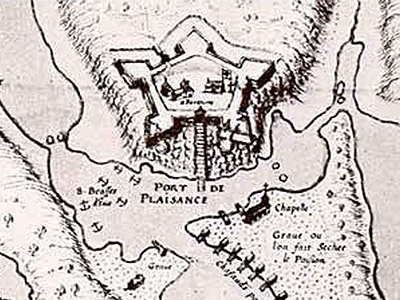 Fort Plaisance, 1675 Fort Plaisance, 1675 |
 |
|
|
Plaisance's population was kept locked in the town's church for six weeks, while the Englishmen indulged in rampant freebootery, which included both stealing everything they could carry off and destroying Fort Plaisance. The British left Plaisance at the beginning of April 1690, gleefully dragging all of the colony's supplies behind them. As the townspersons of Plaisance emerged from their church, blinking in the sunlight, they found themselves sorrowfully starfortless.
|
|
|
 |
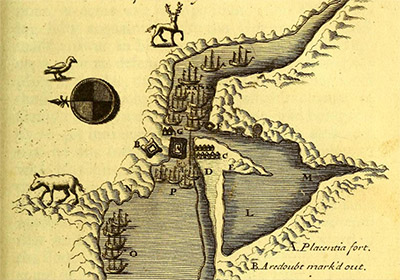 Fort Saint Louis, seemingly precariously balanced on the side of a mountain and marked with B: A redoubt mark'd out. Along with a mammoth stag, bird and...donkeywolf or something. Fort Saint Louis, seemingly precariously balanced on the side of a mountain and marked with B: A redoubt mark'd out. Along with a mammoth stag, bird and...donkeywolf or something. |
|
The surrender of French Governor Jacques-François de Montebon de Brouillan (1651-1705) was demanded by the British, but the Governor refused, and the Royal Navy opened fire on Fort Saint Louis. The intrepid French held out, and the British determined that, unable to get ashore to attack the little fort directly, their expedition was for naught.
For naught, I say! Another Royal Navy squadron of nineteen ships approached Plaisance in August of 1693, but saw the Tricolore still flying o'er Fort Saint Louis and beat a hasty retreat.
|
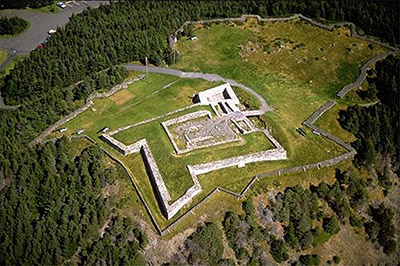 See? Fort Royal is not really as blurry as the satellite image atop this page would suggest. Canada's northern and far eastern extremities are apparently the end of the earth as far as Google Maps is concerned! See? Fort Royal is not really as blurry as the satellite image atop this page would suggest. Canada's northern and far eastern extremities are apparently the end of the earth as far as Google Maps is concerned! |
 |
The starfort that we would like to consider the starfort of our current interest if only it would start existing already finally came into being in 1693. Sited to overlook the harbor, the town of Plaisance and all previous fortifications (a number of small batteries and redoubts had also been built to aid in the defense of Plaisance), Fort Royal was considered so eminently defensible that, in addition to being the town's mighty bastion, it also served as the headquarters for the colony's Governor.
With Fort Royal and its garrison of 60 men protecting Plaisance, French raiding parties sallied forth from this location to spread death and misery to (and steal lots of stuff from) nearby British colonies. |
|
The War of Spanish Succession (1701-1714) brought the British back to Plaisance in 1711, in the form of fifteen ships with 9,000 men and over 900 guns. So determined were they that Plaisance should no longer be a safe haven for French raiding parties that they...left again without capturing the town or damaging much of anything. Whether there was any actual fighting in this instance seems to be either unknown or unworthy of mention, though it seems likely that at the very least, Fort Royal on its commanding hill over the bay struck fear into all 9,000 British hearts.
|
While the French garrison of Fort Royal remained undefeated in war, peace was its undoing. The Treaty of Utrecht (1713), which ended the War of Spanish Succession in the western hemisphere, gave all French possessions in Newfoundland to Great Britain. The French established Louisbourg to the west at relatively nearby Cape Breton Island on Nova Scotia, where they built some pretty impressive starfortage (as the French will do, when left to their own devices), very little of which, sadly, remains today.
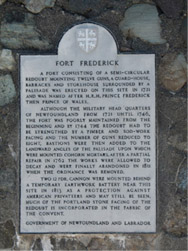 |
 |
The British now owned Fort Royal and all of the other defenses arrayed around Plaisance, which they immediately renamed Placentia, a name that has been scientifically proven to be easier to pronounce for Englishmen.
Despite all of this impressive existing fortification, the British soon began work on their own fort, Fort Frederick. |
|
 |
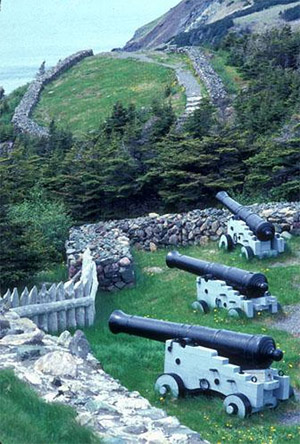 Some of Fort Royal's mighty guns. Some of Fort Royal's mighty guns. |
|
The construction of new fortifications, as opposed to doing what just about every other army did in similar situation, which was to reasonably make use of captured fortifications, seems to be a peculiarly British affectation. Building Fort Crown Point right next to Fort St. Frederick in New York, and the creation of the vast Fort Pitt a few hundred yards from the admittedly destroyed Fort Duquesne in Pennsylvania, are two examples of this phenomenon.
|
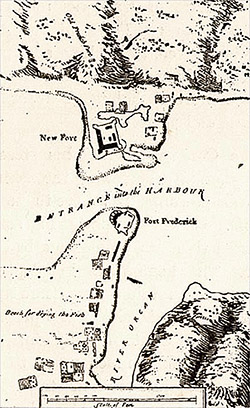 Circa 1740, Fort Frederick in the center, with the "New Fort" to its north...is that Fort Royal? "New" by what estimation? Circa 1740, Fort Frederick in the center, with the "New Fort" to its north...is that Fort Royal? "New" by what estimation? |
 |
The British forts at St. John's, which at the eastern tip of Newfoundland had been Britain's main military stronghold in the region since the end of the 17th century, were much diminished by frequent French attacks, and in the 1720's the bulk of the English military on Newfoundland was moved to Placentia. Fort Frederick served as Britain's military headquarters on Newfoundland from 1721 until 1746. This fort is exquisitely described in the informational plaque above...Which is pretty much all that's left of Fort Frederick today. None of the forts at St. John's remain, which allows my cautious (though reasonably well-informed) claim that Fort Royal is the easternmost fortification in North America. When the French captured St. John's in 1762 during the Seven Years' War (1756-1763), Great Britain recognized the immediate need to upgrade the best-sited fort on what was by then known as Castle Hill overlooking Placentia's harbor, Fort Royal. The fort was given its distinctive appearance, the shape of which is extremely similar to Magazine Fort in Dublin, Ireland, in 1762. This newest iteration of Fort Royal had walls fifteen feet high, with an additional stone wall around the fort's perimeter. Along the inside walls of the fort were wooden platforms, atop which cannon were mounted. A blockhouse stood in the center of the fort. |
|
Unfortunately for those of us wish that Fort Royal had gone on to heroically defend Placentia through countless desperate actions with the French, the Seven Years' War concluded the year after the fort was upgraded, and within ten years it was described as a ruin by neglect. Though France continued its policy of raiding, destroying and/or stealing things from British colonies on the coast of Newfoundland up 'til the end of the 18th century, Placentia lost importance as a military and trading center, and the town declined along with its cool starfort. By 1811, there was no military presence left on Castle Hill.
|
 The rather uninspiring inside of Fort Royal today. The rather uninspiring inside of Fort Royal today. |
 |
Beginning in 1962, the Parks Canada organization "stabilized and interpreted" what was left of Fort Royal, which was opened to the public as part of a Castle Hill National Historic Site in 1968.
While there doesn't appear to really be much of anything inside Fort Royal these days, the nearby Placentia Area Theatre offers a production called Faces of Fort Royal, daily through July and August. This play, performed by local actors (several of whom shamelessly sport non-period eyewear), recreates the life of early French settlers, who are "trying to carry on the business of living in a harsh environment surrounded by enemies." |
|
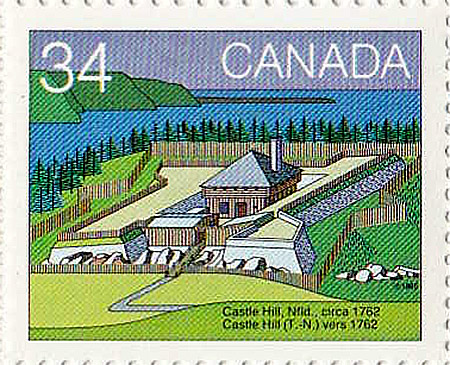 Fort Royal was honored in 1985 as one of twenty Canadian forts Fort Royal was honored in 1985 as one of twenty Canadian forts
represented in the "Forts Across Canada" stamp series.
|
|
|
|
|
|
 |




